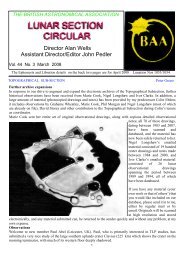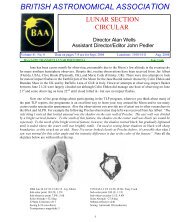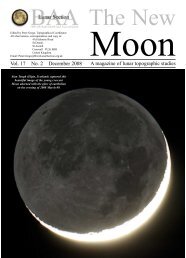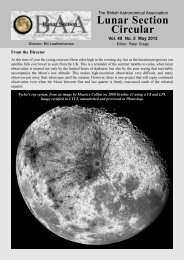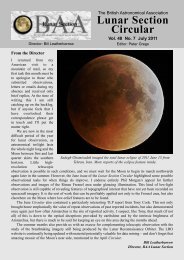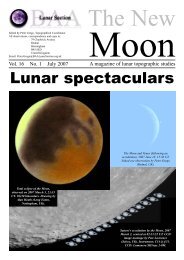Vol 47, No 4, April 2010 - BAA Lunar Section
Vol 47, No 4, April 2010 - BAA Lunar Section
Vol 47, No 4, April 2010 - BAA Lunar Section
You also want an ePaper? Increase the reach of your titles
YUMPU automatically turns print PDFs into web optimized ePapers that Google loves.
Topographical notes<br />
compiled by Peter Grego<br />
Visual studies and observations<br />
Since the last topographical notes in March’s LSC, lunar observational drawings and notes have been received<br />
from Peter Grego (St Dennis, Cornwall, UK), Dale Holt (Chipping, Hertfordshire, UK), Phil Morgan<br />
(Tenbury Wells, Worcestershire, UK), Rob Peeling (SPA member, Stockton-on-Tees, UK) and Graham<br />
Sparrow (SPA member, UK).<br />
Observation of a ‘sunset ray’ in Zeno<br />
Peter Grego<br />
<strong>No</strong>tes: A very favourable libration for this area near the northeastern limb presented this view of late evening<br />
over Zeno and environs very nicely indeed. My attention was captured on seeing the remarkable illumination<br />
of Zeno’s floor; most of it was in shadow save for a clean-cut illuminated triangular section of the floor,<br />
diverging from near the mid-western rim to the inner eastern wall — a so-called ‘sunset ray’. This was made<br />
even more remarkable by the presence of a dark shadow bisecting the eastern inner wall of Zeno A, almost<br />
in line with the ‘sunset ray’; this was likely partly caused by shadow from the small crater Zeno D, which lies<br />
between Zeno and Zeno A. Adjoining, the interior of Zeno B was completely shadowed except its upper inner<br />
eastern wall. The area was full of interest and rather crater-crowded. Traces of Zeno J’s remaining illuminated<br />
eastern rim were visible in the darkness beyond the terminator. Unlike many lunar highland regions, a<br />
number of smooth grey plains were to be found amid the craters here, notably northwest and southwest of<br />
Zeno and at the bottom of the sketch (towards Schumacher, which is not depicted as it lies outside of the area<br />
sketched). In order to depict the changing illumination of the area, a second observation was made around an<br />
hour after the first, using the original sketch as a template (one of the great advantages of cybersketching).<br />
By 01:05 UT the sunset ray in Zeno had faded considerably, the narrowing illuminated section of Zeno’s floor<br />
appearing duskier towards the west, and the edges of the bounding shadow were less distinct than before.<br />
Zeno J’s eastern rim had also faded considerably by this time. Some slight differences in detail between the<br />
sketches are due to copying up and enhancing each observation immediately after each session, plus there<br />
were differences in seeing and also various amounts of observational attention was paid to different areas at<br />
different times. A third observation, made between 01:40 and 01:50 UT, saw Zeno’s floor completely in shadow.<br />
Only a chink of light remained of Zeno J’s wall.<br />
<strong>BAA</strong> <strong>Lunar</strong> <strong>Section</strong> Circular <strong>Vol</strong>. <strong>47</strong> <strong>No</strong>. 4 <strong>April</strong> <strong>2010</strong> 3



